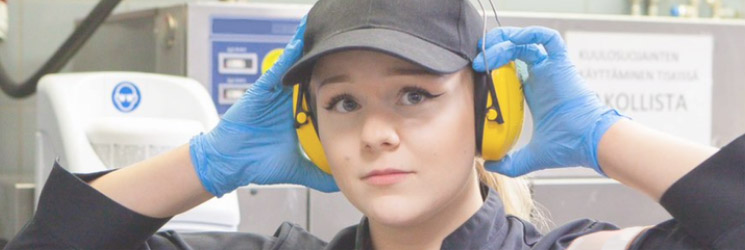

Working conditions
Thermal conditions
General information on topic
Thermal conditions refer to the ambient temperature, humidity and air flow rate in a workplace as well as thermal radiation. These physical conditions have an effect on how a worker is subjected to strain in their work. In addition, the workload is affected by the worker’s personal characteristics, how used to hot or cold temperatures they are, the physical effort involved in their work as well as regular breaks. Clothing can also have a significant effect on the strain caused by hot or cold temperatures. Working in unusually high or low temperatures puts more strain on the body and increases the risk of accidents and health problems.
Working in hot or cold conditions
Working in hot conditions is most frequent in industrial sectors. Hot work includes, for example, melting and casting work, heat treatment, forging and rolling in the metal industry and specific work tasks in the glass and ceramics industry. Workers are also exposed to heat in industrial kitchens, laundries and bakeries. When working outside in the summer, for example, asphalt workers and roofers as well as greenhouse and garden workers can be exposed to high temperatures. Also the operators of vehicles and machinery can be exposed to high temperatures, unless they are equipped with sufficient air-conditioning. Protective equipment and heavy work can cause heat strain even in a cooler environment. Approximately 60,000 workers are estimated to work in high temperatures.
Workers exposed to cold temperatures include workers in agriculture and forestry, construction, food industry and stowage and warehouse work.
Health effects of thermal conditions on workers
A person’s heart rate increases when working in hot conditions as the body tries to release the extra heat by perspiring. In order to cool off the organ system, the hotter the environment and the heavier the work, the more blood is circulated on the skin.
Profuse perspiring affects the maintenance of the body’s fluid and salt balance. A worker who is accustomed to working in hot conditions can produce as much as one litre of sweat in an hour. If the fluid lost is not replaced by drinking, the body will dehydrate. Dehydration strains the circulation, raises the body temperature and increases the risk of sudden heat exhaustion or a heatstroke.
Profuse perspiring in a hot environment irritates the skin and exposes it to various skin lesions and diseases. When working outside, unprotected skin is exposed to UV radiation and sun burns due to the sun. The heat can weaken a person’s balance and, thus, cause a risk of falling.
Working in high temperatures can expose a worker to heat-related conditions, such as heat collapse and heat exhaustion. The first signs of a possible excess heat exposure are fatigue, headache and nausea.
A short-term heat exposure is usually not harmful to a basically healthy person. However, some illnesses, such as respiratory and circulatory system disorders, heart failure and severe kidney disease can prevent working in hot conditions.
Cold conditions can also strain the body and weaken the physical functional capacity. In work situations, the most common issue is the cooling down of hands and feet. The excessive cooling down of the body’s distal parts, such as the fingers and toes and/or the skin can cause frostbite (tissue damages).
Frostbites can occur when the ambient temperature decreases below the freezing point. A strong wind can make the damage worse. Humidity and staying in one place can cause frostbite in the feet, even if the temperature would be above the freezing point. A contact frostbite can occur even within a few seconds, if bare skin touches, for example, the cold metal surface of a tool.
Estimation of thermal conditions and related recommendations
In accordance with the Occupational Safety and Health Act, the employer must establish whether there are factors in the work environment, including thermal conditions, which can pose a risk or harm to the health of employees. If thermal conditions cause a risk or danger, the employer must estimate their significance to the employee’s health and safety, and make a decision on the basis of the estimate on how to resolve or minimise the risk. Short-term exposure to hot or cold work does not usually cause harm to an employee’s health, but it is mainly an issue of feeling comfortable.
In the absence of binding limit values for the employer regarding thermal conditions, the significance of adverse thermal conditions on the workers’ health must be evaluated on a case-by-case basis, in connection with the occupational health care provider’s workplace survey, for example. The following presents recommendations which can be used as an aid when evaluating the thermal conditions in a workplace:
| Physical effort involved in the work | Heat production | Recommended temperature | Air flow rate |
| light desk work | under 150 W | 21–25 °C | less than 0,1 m/s |
| other light work | 150–300 W | 19–23 °C | less than 0,1 m/s |
| moderate work | 300–400 W | 17–21 °C | less than 0,5 m/s |
| hard work | over 400 W | 12–17 °C | less than 0,7 m/s |
The relative air humidity at the workplace should be approximately 30–50%.
Minimising exposure to hot or cold
The employer must take action to improve working conditions especially when the temperature at the workplace exceeds 28 °C or goes below the recommended temperatures as follows:
- 20 °C in the case of light desk work
- 18 °C in the case of other light work
- 15 °C in the case of moderate work, or
- 10 °C in the case of hard work.
The principal ways to protect workers from the risks of working in hot or cold conditions include air conditioning and isolating sources of heat and cold as well as other technical solutions. For example, thermal radiation of the sun can be blocked by shutters. If technical solutions are not an option, the aim is to minimise the effect of thermal conditions on the worker by using appropriate clothing and allowing for regular breaks. In extreme cases, such as in foundry work, personal protective equipment can also be used.
If, regardless of the technical action taken, the ambient temperature in the workplace exceeds 28 °C, the employer must limit the time when the workers are exposed to high temperatures. The duration of one working period can be a maximum of 50 minutes in an hour, if the air temperature at the workplace is 28–33 °C. If the temperature rises above 33 °C, the longest continuous working period cannot be more than 45 minutes per hour. In other words, workers must be provided with an opportunity to spend between 10 and 15 minutes each hour working in a cooler space, or alternatively, to take regular breaks in a cooler space.
Instructions for employee
Notify the employer and the occupational safety and health representative, if the thermal conditions in your workplace significantly deviate from the determined recommendations. If the employer does not have the possibility to use technical solutions to decrease the strain, work must be interrupted by regular breaks as determined above.
If you have to work in hot conditions, you can decrease the thermal strain by wearing light, loose-fitting clothing and by drinking plenty of fluids several times per hour. If possible, breaks should be taken in cool spaces.
Make sure that your employer’s occupational health care provider has evaluated your need for regular health examinations if you work in unusually low or high temperatures (below 10–12 °C or above 28 °C) for long periods of time.
Instructions for employer
No binding limit values have been set for thermal conditions. However, it is the employer’s responsibility to ensure that air temperature, humidity and air flow as well as surfaces that radiate heat or cold pose as little danger or risk as possible to workers’ health and safety. The assessment of thermal conditions is a key component of any workplace survey, and it is the employer’s duty to ensure that their occupational health care provider carries out a sufficiently thorough assessment.
The employer should try, principally by using technical solutions, to prevent the workers from experiencing any hazardous strain caused by hot or cold conditions. If this is not possible, the strain should be interrupted by allowing for regular breaks.
Legislation
Occupational Safety and Health Act (738/2002)
- Section 8 – Employers’ general duty to exercise care
- Section 39 – Physical agents and electrical safety
Government Decree on Safety and Health Requirements in Workplaces (577/2003, in Finnish)
- Section 12 – Windows
- Section 4 – Medical examination
- Section 8 – List of examples
Government Decree on the Safe Use and Inspection of Work Equipment (403/2008)
- Section 13 – Weather conditions
- Section 17 – Cabin requirements


